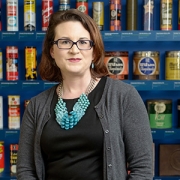Welcome 2019 Affiliate Visiting Professionals!
Smithsonian Affiliations welcomes its 2019 Visiting Professionals Program (VPP) cohort to Washington, D.C.! With support from the Getty Foundation, the VPP reaches a diverse group of Affiliate colleagues working in organizations with art collections and serving diverse audiences. The program provides more in-depth access to Smithsonian subject and technical experts, resources and collections, and allows participants the time and support to tackle a pre-identified challenge for their organization.
The 2019 program focuses on building, leveraging, and sustaining networks to design, develop, and execute digital projects using design thinking skills. Throughout the program, museum expert Marsha Semmel will facilitate sessions on leadership development, change management, and the power of partnerships.
We want to wish a warm Smithsonian welcome to our new cohort! We look forward to sharing resources and tools with them so that they successfully implement their projects at their Affiliate organizations when they return home.
Follow @SIAffiliates and #2019VPP to see what the cohort is up to during their time at the Smithsonian.

Elizabeth Barrett Sullivan
Elizabeth Barrett Sullivan is the Curator of Exhibits at the Arab American National Museum in Dearborn, Michigan. Her challenge is promoting national engagement with contemporary Arab American artists featured in the museum’s permanent collection using digital tools. She will explore ways of enhancing the experience and reach of contemporary artists-in-residence using technology.

Tasha Caswell
Tasha Caswell is a Research & Collections Associate at the Connecticut Historical Society in Hartford, Connecticut. Her challeEnge addresses how the Connecticut Historical Society can deepen its commitment to storytelling by reimagining its approach to providing electronic access to the collection.

Jewel Clark
Jewel Clark is the Digital Technologies and Website Manager at the Heard Museum in Phoenix, Arizona. Her challenge focuses on increasing the ability to reach broader audiences with digital media through exhibition interactives by incorporating digital aspects to storytelling and interpretation.

Melissa de Bie
Melissa de Bie is Director of Collections Access, Senior Registrar at History Colorado in Denver, Colorado. Melissa’s challenge addresses increasing access to and use of art collections through digital resources. She will focus on digital initiatives to meet institutional objectives for statewide impact and accessibility.

Nicole Markham
Nicole Markham is Curator of Collections at the International Tennis Hall of Fame in Newport, Rhode Island. Nicole will explore developing resources and opportunities to engage existing audiences, find new audiences, develop new interactive elements within the museum’s galleries, and expand educational opportunities for the greater public, whether in-person or online.

Kendra Newhall
Kendra Newhall is Senior Curator at Montana Historical Society in Helena, Montana. Kendra’s challenge is digitizing the Poindexter collection to represent the artwork on different platforms, raising awareness of the collection across the state, and providing access to the pieces to individuals across Montana and the world.

Katie Staib
Katie Staib is Director of Education at the Northwest Museum of Arts and Culture in Spokane, Washington. She will explore using digital tools to connect with and engage rural and financially disadvantaged communities.

Teresa Stenstrup
Teresa Stenstrup is Director of Programs at the National Czech & Slovak Museum & Library in Cedar Rapids, Iowa. Teresa’s challenge is increasing the museum’s national footprint and digital visitation with a platform that engages users with the museum’s digital collection.


